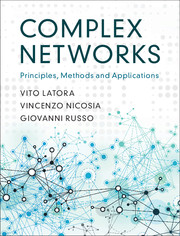Book contents
- Frontmatter
- Dedication
- Contents
- Preface
- Introduction
- Epigraph
- 1 Graphs and Graph Theory
- 2 Centrality Measures
- 3 Random Graphs
- 4 Small-World Networks
- 5 Generalised Random Graphs
- 6 Models of Growing Graphs
- 7 Degree Correlations
- 8 Cycles and Motifs
- 9 Community Structure
- 10 Weighted Networks
- Appendices
- References
- Author Index
- Index
6 - Models of Growing Graphs
Published online by Cambridge University Press: 11 October 2017
- Frontmatter
- Dedication
- Contents
- Preface
- Introduction
- Epigraph
- 1 Graphs and Graph Theory
- 2 Centrality Measures
- 3 Random Graphs
- 4 Small-World Networks
- 5 Generalised Random Graphs
- 6 Models of Growing Graphs
- 7 Degree Correlations
- 8 Cycles and Motifs
- 9 Community Structure
- 10 Weighted Networks
- Appendices
- References
- Author Index
- Index
Summary
Many of the networks around us continuously grow in time by the addition of new nodes and new links. One typical example is the network of the World Wide Web. As we saw in the previous chapter, millions of new websites have been created over recent years, and the number of hyperlinks among them has also increased enormously over time. Networks of citations among scientific papers is another interesting example of growing systems. The size of these networks constantly increases because of the publication of new papers, all arriving with new citations to previously published papers. All the models we have studied so far in the last three chapters deal, instead, with static graphs. For instance, in order to construct random graphs and small-world networks we have always fixed the number N of vertices and then we have randomly connected such vertices, or rewired the existing edges, without modifying N. In this chapter we show that it is possible to reproduce the final structure of a network by modelling its dynamical evolution, i.e. by modelling the continuous addition in time of nodes and links to a graph. In particular, we concentrate on the simplest growth mechanisms able to produce scale-free networks. Hence, we will discuss in detail the Barabási–Albert model, in which newly arrived nodes select and link existing nodes with a probability linearly proportional to their degree, the so-called rich gets richer mechanism, and various other extensions and modifications of this model. Finally, we will show that scale-free graphs can also be produced in a completely different way by means of growing models based on optimisation principles.
Citation Networks and the Linear Preferential Attachment
As authors of scientific publications we are all interested in our articles being cited in other papers’ bibliographies. Citations are in fact an indication of the impact of a work on the research community and, in general, articles of high quality or broad interest are expected to receive many more citations than articles of low quality or limited interest. This is the reason why citation data are a useful source not only to identify influential publications, but also to find hot research topics, to discover new connections across different fields, and to rank authors and journals [87, 194].
- Type
- Chapter
- Information
- Complex NetworksPrinciples, Methods and Applications, pp. 206 - 256Publisher: Cambridge University PressPrint publication year: 2017



